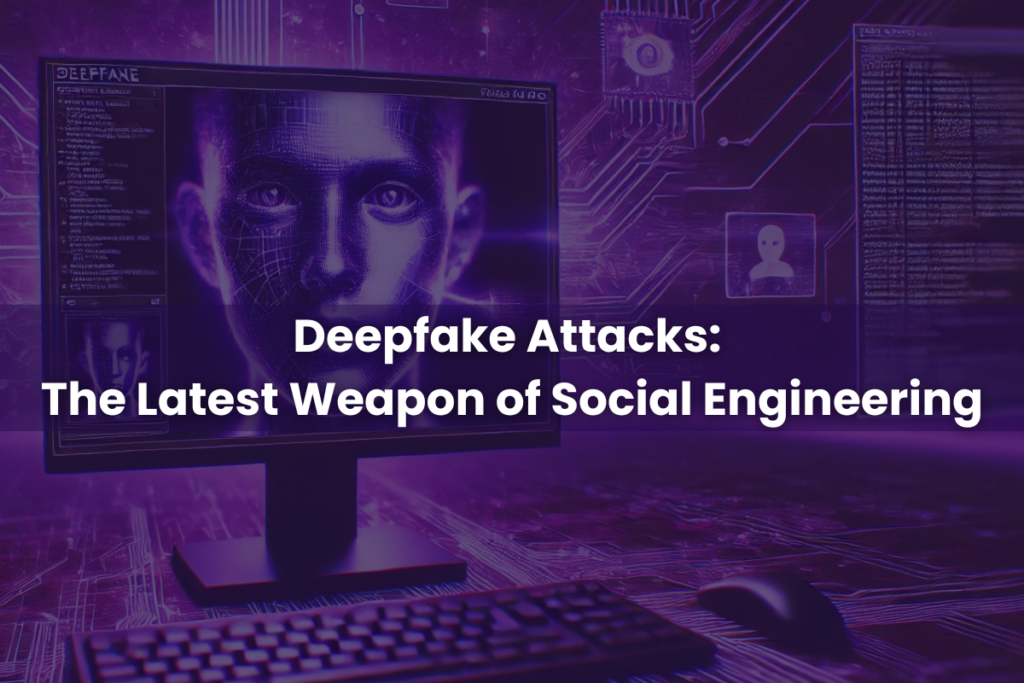Deepfake Attacks: The Latest Weapon of Social Engineering

Often overlooked, social engineering has always been a great weapon for cybercriminals due to its focus on exploiting human weaknesses. Social engineering takes a different approach compared to traditional hacking: instead of focusing on exploiting software vulnerabilities, it seeks to manipulate human weaknesses. It relies on manipulating emotions like trust, fear, and respect for authority, often to obtain access to confidential information or secure systems.
Social engineering attacks usually involve business email compromise (BEC), spear and voice phishing, or pretexting. Although awareness campaigns can help employees spot phishing scams easier, cybercriminals have deployed more complex methods by incorporating a new element into their tactics: artificial intelligence (AI).
Rapid advances in AI and machine learning (ML) have already changed many aspects of our lives, both for better and worse. We are now facing the challenges presented by deepfake attacks, which could lead to destructive security risks. AI is rapidly being used for malicious purposes, and deepfakes are an excellent example of this technology's misuse. While they pose a serious threat to social engineering, they are also increasingly being used for extortion, fraud, and identity theft. This blog post will explore how deepfake attacks are becoming a major threat in cybersecurity.
Seeing is Believing, But to What Extent?
While deepfakes showcase the remarkable advancements in AI and ML, they also represent a significant danger to the integrity of information in today's world. Deepfake attacks manifest in various alarming ways, each presenting unique threats. From manipulating elections and creating nonconsensual pornography, to scams, financial frauds, and identity theft, these are just a few examples of how individuals can be exploited and manipulated in deeply disturbing ways.
Identifying deepfake videos can be difficult, particularly when the impersonation is convincing and the individual appears to be behaving reasonably.The challenge becomes even greater when the context shifts to a medium with which we are more familiar. Cybercriminals can impersonate senior executives or trusted colleagues to deceive employees into disclosing critical information or authorizing huge financial transactions. For example, an employee at a multinational corporation was tricked into sending $25 million to fraudsters who used deepfake technology to imitate the company's CFO during a video call (source: https://globalnews.ca/news/10273167/deepfake-scam-cfo-coworkers-video-call-hong-kong-ai/).
Why Should Your Company be Concerned?
Deepfakes has taken social engineering to a new level. The increasing advancement of deepfake technology and its widespread availability may pose significant concerns for security protocols. The rapid advancements in AI technology often put us in a position of playing catch-up. As we develop new detection techniques, deepfake cybercriminals are already improving their tools, resulting in more complex and elusive ways. But why should your company care?
- It is becoming more powerful and easily accessible
Adding to the challenge is the evolving landscape of AI, as it becomes more powerful and economically accessible, lowering the barriers to misuse. As our online presence continues to grow, malicious actors can take advantage of our data to create realistic impersonations. This trend raises concerns for the cybersecurity community, as well as for various industries and individuals.
- It is usually difficult to detect
AI allows for more sophisticated cyber attacks. Deepfakes can be used to generate realistic phishing emails, voice messages, or video calls which create a sense of urgency, making it more difficult for people to detect scams.
- It gets personal
Deepfakes can be used by attackers to create highly personalized attacks, targeting people based on their specific interests, hobbies, and network of friends. This allows them to exploit vulnerabilities that are unique to certain individuals and organizations.
How Should I Protect My Company?
The integration of GenAI has the potential to significantly increase the effectiveness of cyberattacks. To protect against this evolving threat, companies can implement several measures:
- Employee Awareness and Training
Recognizing the importance of cybersecurity awareness is crucial. When employees are well-informed about cyberattack strategies and know the best practices to follow, they are significantly less susceptible to falling prey to deception.
- Phishing Attacks Simulations Tests
Phishing attack simulation tests, combined with employee training, enable employees to sharpen their responses to real-world attacks. This practice not only helps them manage phishing attempts effectively but also minimizes the chances of them becoming victims.
- Layered Defense Strategy
Establish multiple layers of protection. If one control is breached, companies should make sure that additional safeguards and alerting systems are in place to stop the attack from getting worse.
Although the impact of deepfake attacks is unpredictable, one thing is for sure: they do not discriminate. No matter your industry or business size, deepfakes will have an impact which would lead to destructive consequences.
At Pretera, we understand the urgency of addressing this evolving threat. Our social engineering expertise, red teaming services, and security awareness training are specifically designed to help organizations defend against sophisticated attacks like deepfakes. We empower businesses to recognize potential risks, strengthen their defenses, and ensure their teams are well-prepared for any attack.
Take a proactive stance today to defend against tomorrow’s deepfake attacks. Don’t be the next victim, contact us now!